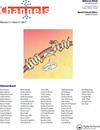天然小脑iFGF14复合物的蛋白质组学分析
IF 3.2
3区 生物学
Q2 BIOCHEMISTRY & MOLECULAR BIOLOGY
引用次数: 9
摘要
细胞内成纤维细胞生长因子14 (iFGF14)和其他细胞内FGFs (iFGF11-13)调节电压门控神经元和心脏Na+ (Nav)通道的性质和密度。最近的研究表明,iFGFs也可以调节天然电压门控Ca2+ (Cav)通道。在本研究中,基于质谱(MS)的蛋白质组学方法被用于鉴定天然小脑iFGF14复合物的成分。利用抗iFGF14抗体,免疫沉淀野生型成年小鼠小脑的天然iFGF14复合物。平行对照实验对从小鼠分离的小脑蛋白(Fgf14−/−)进行,这些蛋白含有Fgf14位点的靶向破坏。免疫沉淀蛋白的质谱分析表明,在天然小脑iFGF14复合物中鉴定的绝大多数蛋白是Nav通道孔隙形成(α)亚基或先前报道的与Nav α亚基相互作用的蛋白。相比之下,小脑iFGF14免疫沉淀物中未发现Cav通道α或附属亚基。使用抗pannav抗体对野生型和Fgf14 - / -小鼠小脑的Nav通道复合物进行免疫沉淀。Western blot和MS分析显示,iFGF14的缺失不会显著影响天然成年小鼠小脑Nav通道复合物中蛋白质组成或Nav通道相互作用蛋白的相对丰度。本文章由计算机程序翻译,如有差异,请以英文原文为准。
Proteomic analysis of native cerebellar iFGF14 complexes
ABSTRACT Intracellular Fibroblast Growth Factor 14 (iFGF14) and the other intracellular FGFs (iFGF11-13) regulate the properties and densities of voltage-gated neuronal and cardiac Na+ (Nav) channels. Recent studies have demonstrated that the iFGFs can also regulate native voltage-gated Ca2+ (Cav) channels. In the present study, a mass spectrometry (MS)-based proteomic approach was used to identify the components of native cerebellar iFGF14 complexes. Using an anti-iFGF14 antibody, native iFGF14 complexes were immunoprecipitated from wild type adult mouse cerebellum. Parallel control experiments were performed on cerebellar proteins isolated from mice (Fgf14−/−) harboring a targeted disruption of the Fgf14 locus. MS analyses of immunoprecipitated proteins demonstrated that the vast majority of proteins identified in native cerebellar iFGF14 complexes are Nav channel pore-forming (α) subunits or proteins previously reported to interact with Nav α subunits. In contrast, no Cav channel α or accessory subunits were revealed in cerebellar iFGF14 immunoprecipitates. Additional experiments were completed using an anti-PanNav antibody to immunoprecipitate Nav channel complexes from wild type and Fgf14−/− mouse cerebellum. Western blot and MS analyses revealed that the loss of iFGF14 does not measurably affect the protein composition or the relative abundance of Nav channel interacting proteins in native adult mouse cerebellar Nav channel complexes.
求助全文
通过发布文献求助,成功后即可免费获取论文全文。
去求助
来源期刊

Channels
生物-生化与分子生物学
CiteScore
5.90
自引率
0.00%
发文量
21
审稿时长
6-12 weeks
期刊介绍:
Channels is an open access journal for all aspects of ion channel research. The journal publishes high quality papers that shed new light on ion channel and ion transporter/exchanger function, structure, biophysics, pharmacology, and regulation in health and disease.
Channels welcomes interdisciplinary approaches that address ion channel physiology in areas such as neuroscience, cardiovascular sciences, cancer research, endocrinology, and gastroenterology. Our aim is to foster communication among the ion channel and transporter communities and facilitate the advancement of the field.
 求助内容:
求助内容: 应助结果提醒方式:
应助结果提醒方式:


